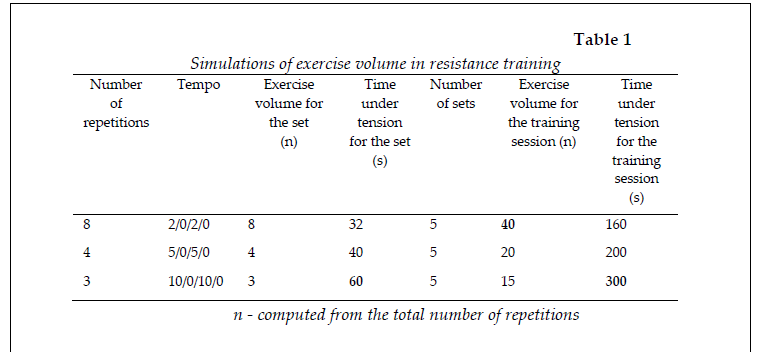We’ve seen in an earlier post how the acute program variables of strength training affect the degree to which the neuromuscular, neuroendocrine, and musculoskeletal systems adapt to training. Prescribing a progressive resistance training program involves manipulation of variables such as exercise intensity, volume, sets and repetitions to induce specific training adaptations. But did you know that the speed of your lifts is another variable that can significantly influence training adaptations?
Repetition speed refers to how fast you’re lifting the weight or performing the movement. The tempo in which you’re lifting can be broken into three separate movements:
- Concentric, or muscle shortening phase
- Isometric, or transition phase
- Eccentric, or muscle lengthening phase
Changing the tempo or speed of each of these specific phases will alter the overall results and is a creative way to progressively overload your training and increase your strength gains, muscle growth, and weight loss, rather than simply lifting more or adding extra repetitions or sets.
Time Under Tension
First, let’s define a few important terms:
- Tempo: refers to the rate at which the repetition is performed1
- Time under tension (TUT) refers to the amount of time a muscle is held under tension or strain during an exercise set.
The number of repetitions performed at specific tempos influences the total TUT. The TUT provides accurate information about the duration of the resistance effort of your session. During TUT workouts, you slow down the tempo of the lift, forcing your muscles to hold the weight for longer and remain activated for more time. You can lengthen each phase of the movement, or specific phases, to make your sets longer. The idea is that this forces your muscles to work harder and optimizes muscular strength, endurance, and growth. The table below shows simulations of exercise volume based on the number of repetitions performed and time under tension. Wilk et al1 evaluated the effect of varying tempos during resistance exercises on training volume based on number of repetitions and TUT. With slow movement tempos of 5 to 20s per repetition, fewer lifts are performed but there is a longer TUT than for higher repetitions performed at a faster tempo.

The idea of training slow is to bring the muscles to exhaustion by keeping them loaded throughout the movement. At faster movement speeds, higher levels of maximal muscle force are generated when compared to force recorded during slower tempo movements. With faster movement speeds, can typically perform more repetitions with a specific %RM load. Using a slower movement pattern, even with a lower number of total repetitions produces greater post-exercise fatigue1.
If that’s the case, then why change the tempo?
When you lift a weight, during the eccentric (lengthening) phase, elastic energy is stored to be released during the concentric phase. This is known as the stretch-shortening cycle (SSC) and acts similarly to drawing tension in a bow and arrow. By slowing the movement, you decrease the use of the elastic energy in the SSC and increase the amount of muscular tension generated to lift the weight, so we get greater muscle involvement, and subsequently greater muscle growth!
Greater Muscle Growth
As we saw in our earlier blog on Rep Ranges, all forms of resistance training lead to some degree of hypertrophy and increased strength. Training with a controlled movement tempo can induce different post-exercise responses and long-term adaptations. Slower, controlled movements are often used to stimulate muscle hypertrophy2; vs. faster, uncontrolled movements which are typically employed to develop strength and muscle power1,3.
The magnitude of the hypertrophy response to resistance training depends not only on the intensity of the exercise being performed, but also on the length of time the muscle is being loaded3. So, TUT is an important variable for optimising muscle growth. Hypertrophy is sensitive to TUT, the longer the muscles stay strained influences the degree of increase in muscle size. Using a slow lifting movement to fatigue produces greater increases in rates of muscle protein synthesis than the same movement performed rapidly4.
Changing the cadence of the different phases of the movements also impacts the muscular adaptations. Slower cadence in the eccentric (muscle lengthening) phase have a greater impact on muscle hypertrophy than extending the time of the concentric phase1. This may be because of a fatiguing effect of greater eccentric time under tension. Martins-Costa5 analysed the effect of different repetition durations on muscle activation and blood lactate responses during the bench press. Subjects completed one of two protocols, matched for intensity (same % 1RM), number of sets/reps, and rest intervals. They showed that by adding just 2s to the eccentric action, when using the same load you can increase muscle activation and blood lactate response. Schuenke6 also showed that slow speed training induced a greater adaptive response to training at normal speed with the same load in women performing leg press, squats, and knee extension.
In addition to the hypertrophy response, the tempo of the repetitions also has implications for energy expenditure. Lifting with a slower tempo, when controlled for the same relative load, increases the total energy expenditure7 (largely due to increased anaerobic work), and increases the metabolic response to training to a greater extent than merely lifting heavier loads8.
These studies reinforce the notion that repetition duration can be an alternative load progression during resistance training programs.
Greater biofeedback and reduced injury risk
The benefits of introducing some slower tempo sessions into your program extend beyond just the strength & hypertrophy adaptations. Generally, the faster you move through a lift, the greater your risk of injury. If you take the time to learn how to execute each movement properly with correct form and stability throughout every repetition you are less likely to injure yourself. Technique is more important than speed when it comes to lifting weights, and if you’re not performing the movement correctly you won’t be properly recruiting the desired muscles, and smaller supporting muscles may take over and get injured. By training at a slower velocity you can critique your own form and self-correct as you perform the exercise.
How to Incorporate in your training
To increase the TUT of your session, simply slow the movements down. You may have to use a lighter weight since the increased time under strain will be difficult to maintain. But to maximise the benefits of increased TUT without having to lower the weight you are lifting, try to keep the repetition duration between 4-6s. We don’t want to slow down so much the weight you use significantly drops, we just want to control the weight and speed of the movement. The recommended “gold standard” cadence is described as 2s concentric, 1s pause, then 4s eccentric3.
For maximum muscle growth, do at least 4 to 6 sets of 6 to 12 repetitions for each exercise using a weight that is heavy enough to cause muscle fatigue by the end of the set (again, see previous post on Rep Ranges). As we’ve seen, tempo lifting can be used to elicit hypertrophy, strength, and endurance, but each one of these goals is achieved through different eccentric tempos:

If you watch experienced weight lifters, you’ll see they have short rests between each repetition (< 3-5s) and a typical set of 6–8 repetitions lasting approximately 12–16 seconds at a fast repetition tempo vs. up to a minute for a set with a slower repetition tempo.
References
- Wilk M, Golas A, Stastny P, Nawrocka M, Krzysztofik M, & Zajac A (2018) Does tempo of resistance exercise impact training volume? Journal of Human Kinetics. 62(1): 241-250
- Guucio JP, Sugg KB, Mendias CL (2015) TGF-β superfamily signalling in muscle and tendon adaptation to resistance exercise. Exercise and Sport Science Review. 43:93
- Bird SP, Tarpenning KM, & Marino FE (2005) Designing resistance training programmes to enhance muscular fitness: A review of the acute programme variables. Sports Medicine. 35(10): 841-851
- Burd NA, Andrews RJ, West DWD et al (2012) Muscle time under tension during resistance exercise stimulates differential muscle protein sub-fractional synthetic responses in men. Journal of Physiology. 15(2): 351-362
- Martins-Costa HC, Diniz RCR, Lima FV et al (2016) Longer repetition duration increases muscle activation and blood lactate response in matched resistance training protocols. Motriz: Revista de Educacao Fisica. 22(1): 35-41
- Schuenke MD, Herman JR, Gliders RM et al (2012) Early phase muscular adaptations in response to slow-speed versus traditional resistance-training regimens. European Journal of Applied Physiology. 112: 3585-3595
- Scott CB (2012) The effect of time under tension and weight lifting cadence on aerobic, anaerobic, and recovery energy expenditures: 3 submaximal sets. Applied Physiology, Nutrition, & Metabolism. 37: 252-256
- Corradi EFF, Lanza MB, Lacerda LT et al (2020) Acute physiological responses with varying load or time under tension during a squat exercise: a randomized cross-over design. Journal of Science & Medicine in Sport. In Press. DOI:https://doi.org/10.1016/j.jsams.2020.07.015
